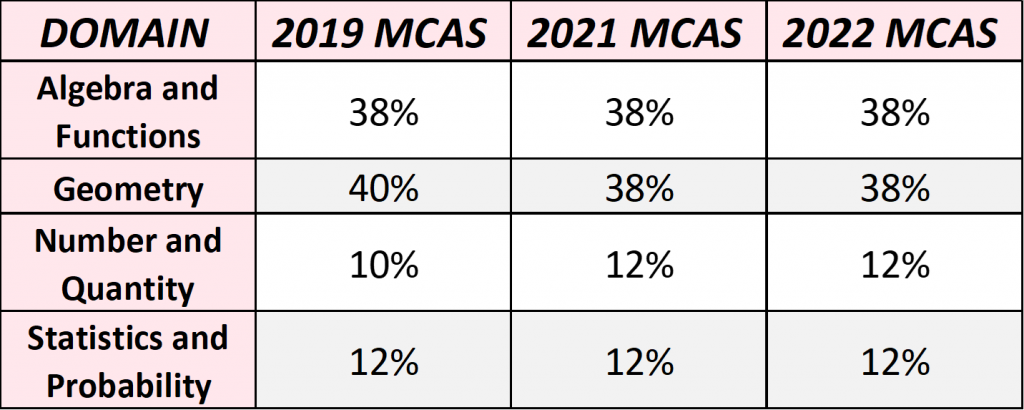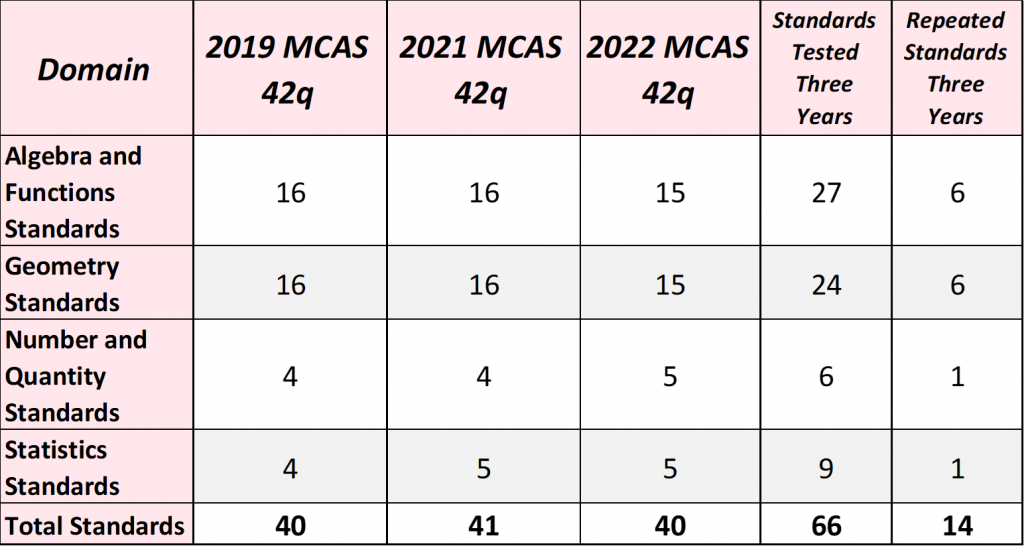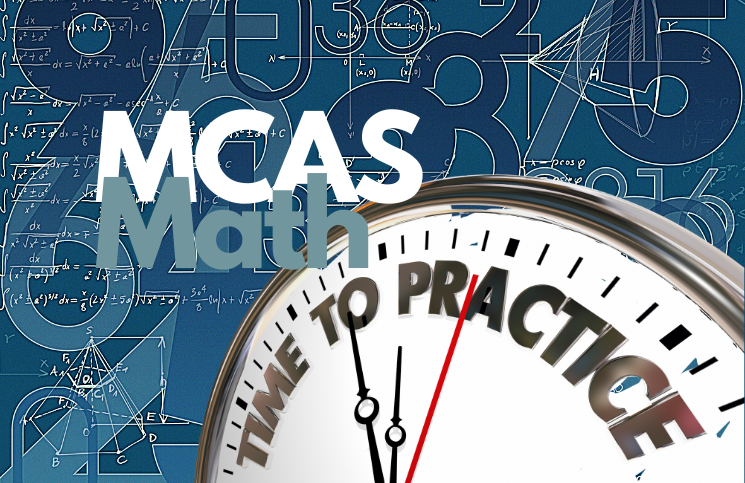By Joan Reissman
TIP: Cover standards that have been on previous tests
Students need to pass the 10th grade MCAS tests in order to graduate. Test preparation is not a substitute for long-term cumulative learning; but review and practice is a tried and true way to refresh and strengthen skills and build knowledge. Practice exercises constructed in the format students will encounter on the actual assessments can reinforce the skills as effectively as any other form of review—maybe more effectively. The MCAS test is a subset of the state curriculum standards. All MCAS questions are drawn directly from the curriculum standards. There is no conflict between “teaching to the test” and teaching the standards that are assessed by the test. The 10th grade math MCAS begins May 16, just 5 weeks after Easter. And one of those weeks is April vacation. But there’s still time to prepare.
With focus and organization, students can review the necessary material. JFYNetWorks has an online curriculum and teacher support to help students refresh the 9th and 10th grade skills that are covered on the 10th grade MCAS. JFYNetWorks’ curriculum provides flexible options for MCAS preparation that can be seamlessly integrated into daily classes. Selecting from our comprehensive online curriculum that covers all math standards, we help teachers focus on the topics that are most likely to be tested. Last year we recommended 24 frequently-tested MCAS 2.0 standards. That package still provides a solid foundation. Since we now have 3 years of testing to compare, we can modify our online curriculum to cover the 14 standards that have been tested in all three years. It’s best to cover as much material as possible, but we can choose topics that focus preparation most effectively for a class or a student. We provide the curriculum to schools and train teachers to use it, at no cost. Some JFY partner schools recovered all learning loss in 2022, regaining 2019 levels. (Inquiries can be sent to info@jfynet.org.)
We now have three years of Next Generation MCAS 2.0 behind us (2019, 2021 and 2022). With three years of released tests, we have a substantial foundation to analyze patterns. In 2019 the Next Generation 10th grade test transitioned to the revised mathematics standards that were adopted in 2017. This transition created a significant change in the distribution of domains. MCAS 2.0 has a much higher proportion of algebra and geometry than the old test. This table shows the domain distribution in 2019, 2021 and 2022:

The domain distribution over the past three years is nearly identical. That doesn’t mean all the questions cover exactly the same standards (see below), but the domain distribution has remained consistent. We can be fairly confident that the nearly 80% emphasis on Algebra and Geometry will continue in MCAS testing. This distribution reflects the 2017 standards revision. On the old Legacy MCAS, Statistics and Number and Quantity were a much higher percentage of the test.

Both the standards tested and the number of questions each year are very similar. The number of standards tested in each domain is consistent, but different standards were tested within the domains. Each year there have been 42 questions, but almost every question derives from a different standard within the domain (40-41 standards). Each question is based on an identified state standard. In the 126 questions over the three years, 25 standards have appeared only one time; twenty-seven standards have been repeated twice; and only 14 standards have been on the exam all three years. So out of the 126 total questions, 66 standards have been tested at least once. (There are a total of 101 standards in the high school curriculum frameworks.) That’s part of the good news.
But the really good news is that 14 standards were tested all three years. MCAS selection isn’t set in stone, so it’s best to focus on the 24 frequently-tested standards for the next 5 weeks. However, reviewing the core 14 standards will give students a solid foundation for a likely nucleus of content. And because these are all grade-level standards, students will need them to be prepared for 11th grade. As explained above, MCAS is a subset of grade-level standards.
It’s important to remember that the distribution of domain strands has been consistent during the past three years. For example, last year’s test had a little more emphasis on functions and a little less on transformation, but MCAS has still tested the same number of standards in algebra and geometry all three years. There is overlapping content in the standards, and JFY can help teachers focus on delivering the essential components within the standards. If students finish the 14 or 24 standards, they can go on to the remaining standards that appeared in only one of the years. Review emphasis should depend on the course students are currently taking. For example, students in a traditional geometry course will need more review of algebra topics.
Testing Techniques
Our focus is on learning content, but it doesn’t hurt to review some testing techniques. One of the most important things a teacher can do is to help students build confidence answering constructed response questions. Students should be encouraged not to give up and just leave this part blank. Even if they can’t answer everything, they will get some points for answering part of the question. Go to https://www.doe.mass.edu/mcas/student/ and have students choose scores on sample constructed response questions. Show them how just answering part of the question will still yield points.
It is also helpful to share some time-tested strategies for answering questions. One strategy is the venerable process of elimination. This is a student’s last-ditch effort when she has no idea what the answer is. If there are 4 possible answers, she always has a twenty-five percent chance of making the correct selection. There are other techniques that help with multiple choice questions. One method is working backwards. Take the given choices and see if any of them gives the correct answer to the problem. This technique might work well when the problem has variables and the answer choices are numbers. One final technique is called plugging in. If you have variables in the problem and the answer choices, try using some simple numbers (not 0 and 1 J) and see if you can answer the questions.
And don’t forget to remind students about the reference sheet found here. It has valuable and usable information. Keep in mind that these techniques are not a substitute for math learning, but they can be helpful to nervous testers.
Although many educators think we still have a long way to go in recovering from pandemic learning loss, students are in a better position this year. They have completed 80 percent of the school year under normal circumstances, but that doesn’t mean they don’t need review. Bridging past years’ skills through acceleration will get students closer to where they need to be and give them a better foundation for demonstrating competence on MCAS and in future classes.
Teachers should make sure to cover standards that have been on previous tests, especially those that have appeared all three years. If there’s time, go for all 24 standards. But at least cover the 14 that have been on the test all three years. Remember: 24 or 14–Practice!
Joan Reissman, the MCAS Maven, is a JFYNetWorks learning specialist.
Other posts authored by Joan can be found here.
MCAS MAVEN coaching tips found here.
HOW ARE WE DOING? In our pursuit to serve up content that matters to you, we ask that you take a couple of minutes to let us know how we’re doing? Please click here to be navigated to our JFYNet Satisfaction Survey. Thank you!





